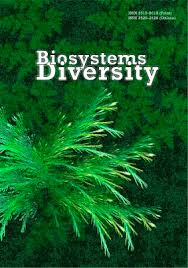Features of exogenous development of Trichuris globulosa (Nematoda, Trichuridae)
Features of exogenous development of Trichuris globulosa (Nematoda, Trichuridae)
Author(s): V. O. Yevstafieva, V. V. Melnychuk, N. S. Kanivets, N. I. Dmitrenko, L. P. Karysheva, S. V. FilonenkoSubject(s): Sociobiology
Published by: Дніпропетровський національний університет імені Олеся Гончара
Keywords: trichurosis; helminth egg; embryogenesis; temperature factor; metric indicators;
Summary/Abstract: Parasitic nematodes of the genus Trichuris Röderer, 1761 are hematophagous helminths, capable of parasitizing many different hosts including humans. The domestic and wild ruminants are hosts of several Trichuris species, with Trichuris globulosa (Linstow, 1901) one of the most prevalent parasites found in cattle. The exogenous stages of the helminth’s life cycle develop in the outer environment, and their activity and survival depend on the abiotic factors. Thus the aim of the work was to determine the influence of temperature on the rate and success of development of infectious eggs of T. globulosa in laboratory culture considering their morphological and metric changes. The results of experimental studies showed that the embryogenesis of T. globulosa eggs, cultured in laboratory conditions and obtained from gonads of female nematodes, occurs in six stages regardless of the temperature regime. At the same time, the rate of transition from one stage to another, the term for the formation of infectious eggs and their viability directly depends on the temperature of the external environment. At the optimal temperature for the development of T. globulosa eggs, 25 °C, 76.3% of eggs reached the mobile larva stage. A decrease in temperature to 20 °C and an increase to 30° C led to an increase in the egg mortality of up to 26% and 32%, respectively, and the viability of eggs decreased. Under such temperature conditions, 74% and 68% of eggs of Trichuris reached the mobile larva stage. With an increase in the culture temperature, the time of embryogenesis decreased and amounted to 56 days at 20 °C, 48 days at 25 °C, and 32 days at 30 °C. Depending on the temperature regime, the zygote stage lasted from the release of eggs from the gonads of female nematodes to 12 days, the stage of blastomere formation from 4 to 12 days, the stage of the bean-shaped embryo from 8 to 24 days, the stage of the tadpole embryo from 16 to 36 days, the stage of larval formation lasted from 16 to 48 days, the stage of mobile larva from days 20 to 56. The formation of the infectious T. globulosa egg from a non-infectious one is shown in an experiment to include the metric changes confirmed by metric indicators. Mature eggs with a mobile larva are shorter and wider, with shorter and narrower plugs and a thinner shell than eggs at the zygote stage. The obtained research results on the influence of temperature on the exogenous development of Trichuris globulosa will make it possible to predict the epizootic situation of trichurosis in animal husbandry, as well as take timely measures to arrest the embryonic stages of nematode development in the external environment.
Journal: Biosystems Diversity
- Issue Year: 28/2020
- Issue No: 4
- Page Range: 337-342
- Page Count: 6
- Language: English

